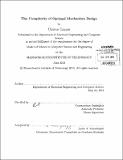| dc.contributor.advisor | Constantinos Daskalakis. | en_US |
| dc.contributor.author | Tzamos, Christos | en_US |
| dc.contributor.other | Massachusetts Institute of Technology. Department of Electrical Engineering and Computer Science. | en_US |
| dc.date.accessioned | 2013-11-18T19:15:11Z | |
| dc.date.available | 2013-11-18T19:15:11Z | |
| dc.date.copyright | 2013 | en_US |
| dc.date.issued | 2013 | en_US |
| dc.identifier.uri | http://hdl.handle.net/1721.1/82373 | |
| dc.description | Thesis (S.M.)--Massachusetts Institute of Technology, Dept. of Electrical Engineering and Computer Science, 2013. | en_US |
| dc.description | Cataloged from PDF version of thesis. | en_US |
| dc.description | Includes bibliographical references (p. 63-64). | en_US |
| dc.description.abstract | Myerson's seminal work provides a computationally efficient revenue-optimal auction for selling one item to multiple bidders. Generalizing this work to selling multiple items at once has been a central question in economics and algorithmic game theory, but its complexity has remained poorly understood. We answer this question by showing that a revenue-optimal auction in multi-item settings cannot be found and implemented computationally efficiently, unless ZPP = P # p. This is true even for a single additive bidder whose values for the items are independently distributed on two rational numbers with rational probabilities. Our result is very general: we show that it is hard to compute any encoding of an optimal auction of any format (direct or indirect, truthful or non-truthful) that can be implemented in expected polynomial time. In particular, under well-believed complexity-theoretic assumptions, revenue-optimization in very simple multi-item settings can only be tractably approximated. We note that our hardness result applies to randomized mechanisms in a very simple setting, and is not an artifact of introducing combinatorial structure to the problem by allowing correlation among item values, introducing combinatorial valuations, or requiring the mechanism to be deterministic (whose structure is readily combinatorial). Our proof is enabled by a flow interpretation of the solutions of an exponential-size linear program for revenue maximization with an additional supermodularity constraint. | en_US |
| dc.description.statementofresponsibility | by Christos Tzamos. | en_US |
| dc.format.extent | 64 p. | en_US |
| dc.language.iso | eng | en_US |
| dc.publisher | Massachusetts Institute of Technology | en_US |
| dc.rights | M.I.T. theses are protected by
copyright. They may be viewed from this source for any purpose, but
reproduction or distribution in any format is prohibited without written
permission. See provided URL for inquiries about permission. | en_US |
| dc.rights.uri | http://dspace.mit.edu/handle/1721.1/7582 | en_US |
| dc.subject | Electrical Engineering and Computer Science. | en_US |
| dc.title | The complexity of optimal mechanism design | en_US |
| dc.type | Thesis | en_US |
| dc.description.degree | S.M. | en_US |
| dc.contributor.department | Massachusetts Institute of Technology. Department of Electrical Engineering and Computer Science | |
| dc.identifier.oclc | 862074655 | en_US |
